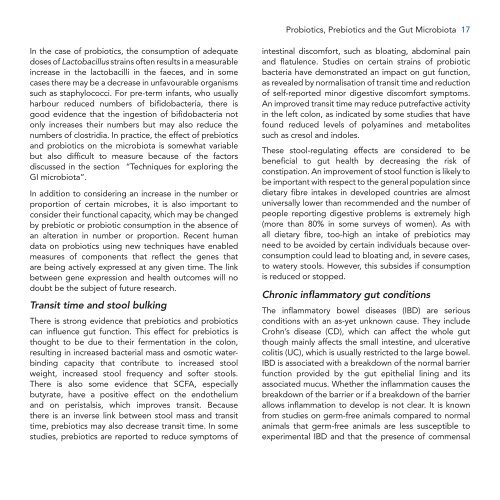probiotics, prebiotics and the gut microbiota - International Life ...
probiotics, prebiotics and the gut microbiota - International Life ...
probiotics, prebiotics and the gut microbiota - International Life ...
You also want an ePaper? Increase the reach of your titles
YUMPU automatically turns print PDFs into web optimized ePapers that Google loves.
Probiotics, Prebiotics <strong>and</strong> <strong>the</strong> Gut Microbiota 17In <strong>the</strong> case of <strong>probiotics</strong>, <strong>the</strong> consumption of adequatedoses of Lactobacillus strains often results in a measurableincrease in <strong>the</strong> lactobacilli in <strong>the</strong> faeces, <strong>and</strong> in somecases <strong>the</strong>re may be a decrease in unfavourable organismssuch as staphylococci. For pre-term infants, who usuallyharbour reduced numbers of bifidobacteria, <strong>the</strong>re isgood evidence that <strong>the</strong> ingestion of bifidobacteria notonly increases <strong>the</strong>ir numbers but may also reduce <strong>the</strong>numbers of clostridia. In practice, <strong>the</strong> effect of <strong>prebiotics</strong><strong>and</strong> <strong>probiotics</strong> on <strong>the</strong> <strong>microbiota</strong> is somewhat variablebut also difficult to measure because of <strong>the</strong> factorsdiscussed in <strong>the</strong> section “Techniques for exploring <strong>the</strong>GI <strong>microbiota</strong>”.In addition to considering an increase in <strong>the</strong> number orproportion of certain microbes, it is also important toconsider <strong>the</strong>ir functional capacity, which may be changedby prebiotic or probiotic consumption in <strong>the</strong> absence ofan alteration in number or proportion. Recent hum<strong>and</strong>ata on <strong>probiotics</strong> using new techniques have enabledmeasures of components that reflect <strong>the</strong> genes thatare being actively expressed at any given time. The linkbetween gene expression <strong>and</strong> health outcomes will nodoubt be <strong>the</strong> subject of future research.Transit time <strong>and</strong> stool bulkingThere is strong evidence that <strong>prebiotics</strong> <strong>and</strong> <strong>probiotics</strong>can influence <strong>gut</strong> function. This effect for <strong>prebiotics</strong> isthought to be due to <strong>the</strong>ir fermentation in <strong>the</strong> colon,resulting in increased bacterial mass <strong>and</strong> osmotic waterbindingcapacity that contribute to increased stoolweight, increased stool frequency <strong>and</strong> softer stools.There is also some evidence that SCFA, especiallybutyrate, have a positive effect on <strong>the</strong> endo<strong>the</strong>lium<strong>and</strong> on peristalsis, which improves transit. Because<strong>the</strong>re is an inverse link between stool mass <strong>and</strong> transittime, <strong>prebiotics</strong> may also decrease transit time. In somestudies, <strong>prebiotics</strong> are reported to reduce symptoms ofintestinal discomfort, such as bloating, abdominal pain<strong>and</strong> flatulence. Studies on certain strains of probioticbacteria have demonstrated an impact on <strong>gut</strong> function,as revealed by normalisation of transit time <strong>and</strong> reductionof self-reported minor digestive discomfort symptoms.An improved transit time may reduce putrefactive activityin <strong>the</strong> left colon, as indicated by some studies that havefound reduced levels of polyamines <strong>and</strong> metabolitessuch as cresol <strong>and</strong> indoles.These stool-regulating effects are considered to bebeneficial to <strong>gut</strong> health by decreasing <strong>the</strong> risk ofconstipation. An improvement of stool function is likely tobe important with respect to <strong>the</strong> general population sincedietary fibre intakes in developed countries are almostuniversally lower than recommended <strong>and</strong> <strong>the</strong> number ofpeople reporting digestive problems is extremely high(more than 80% in some surveys of women). As withall dietary fibre, too-high an intake of <strong>prebiotics</strong> mayneed to be avoided by certain individuals because overconsumptioncould lead to bloating <strong>and</strong>, in severe cases,to watery stools. However, this subsides if consumptionis reduced or stopped.Chronic inflammatory <strong>gut</strong> conditionsThe inflammatory bowel diseases (IBD) are seriousconditions with an as-yet unknown cause. They includeCrohn’s disease (CD), which can affect <strong>the</strong> whole <strong>gut</strong>though mainly affects <strong>the</strong> small intestine, <strong>and</strong> ulcerativecolitis (UC), which is usually restricted to <strong>the</strong> large bowel.IBD is associated with a breakdown of <strong>the</strong> normal barrierfunction provided by <strong>the</strong> <strong>gut</strong> epi<strong>the</strong>lial lining <strong>and</strong> itsassociated mucus. Whe<strong>the</strong>r <strong>the</strong> inflammation causes <strong>the</strong>breakdown of <strong>the</strong> barrier or if a breakdown of <strong>the</strong> barrierallows inflammation to develop is not clear. It is knownfrom studies on germ-free animals compared to normalanimals that germ-free animals are less susceptible toexperimental IBD <strong>and</strong> that <strong>the</strong> presence of commensal
















